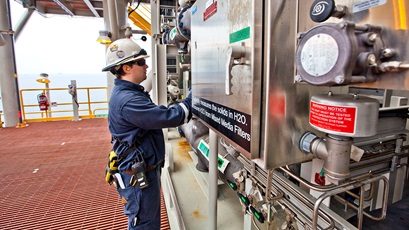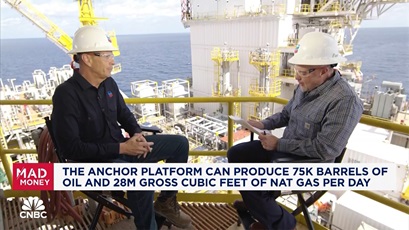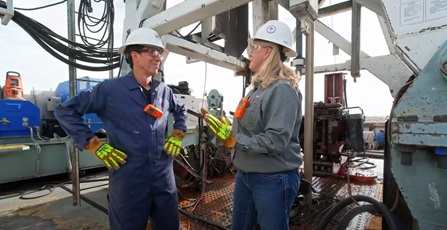our operations
new life for old platforms in the gulf of thailand
3 min read | october 31, 2022
Several of Chevron’s retired offshore platform jackets now serve as artificial reefs in the Gulf of Thailand, where scientists say they create ecological value by providing local fish populations with a habitat.
why it matters
Marine experts agree that overfishing has sunk fish populations in the Gulf of Thailand, but as prime real estate for species spawning, the artificial reefs that we’ve created are helping marine life flourish.
You might think Chevron marine biologist Dr. Michael Marnane would feel like a fish out of water working for an oil and gas company. Instead, he takes pleasure in using his expertise to help protect ocean habitats by utilizing retired platform jackets.
“The Gulf of Thailand is heavily overfished, and preserving any of those fish species is beneficial,” Dr. Marnane said.
“Around stationary oil and gas structures, we are detecting some rare species, including some species of billfish that are fairly rare because they’ve been fished out of so many places.”
hotel for fish
There’s a reason fish like to congregate around upright oil and gas platform jackets. The 75-meter structures, which extend from seabed to surface, allow a variety of species to populate different depths.
“It’s not quite the same as a coral reef habitat, but it is still fairly complex,” Dr. Marnane said. “It doesn’t have all the tiny holes and caves a coral reef has, but it does have vertical relief in the water column. The vertical structure is what’s making this so productive.”
If a coral reef is like a two-story house, then a platform jacket is a skyscraper, Dr. Marnane explained.
“At multiple levels, there is a habitat for fish to thrive,” he said. “Because the structure goes so far up in the water column, it’s able to hold a high biomass of fish.”

Marine organisms can be seen one year after the jacket’s placement. Photo was provided by the Department of Marine and Coastal Resources (DMCR).
sink and swim
When platform jackets are removed from their original locations and transported to reefing sites, they’re toppled onto their sides but still serve as popular marine life hangouts.
Our Gulf of Thailand reefing project began in August 2020 when seven of our jackets were towed to a reefing site more than 80 miles away.
- A Chevron-sponsored scientific study found the original platform jacket location to be conducive to fish spawning.
- Scientists from Curtin University and Chulalongkorn University investigating fish around oil and gas jackets observed marine life compositions before they were removed, as they were towed and after they were relocated.
- They counted more than 10,600 fish and 31 species throughout the process, which suggests that reefed jackets may begin to provide ecological and socioeconomic value almost immediately.
- Some species followed along as the jackets were towed, while others colonized the jackets soon after they were reefed. The research demonstrated that oil and gas jackets can be productive places for fish rather than simply an aggregation site.

A platform jacket in the Gulf of Thailand is pictured being towed to the reef site.
staying afloat
Worldwide, most jurisdictions require decommissioned oil and gas structures to be removed from the water. Chevron was the first Gulf of Thailand operator permitted to repurpose defunct jackets as artificial reefs—albeit away from their original sites.
When operational jackets remain in their original position in an oil or gas field, they’re guarded by a 500-meter buffer zone as required by Thailand law for safety purposes.
The combination of being protected from fishers and having a viable spawning habitat could help species thrive long-term in the region. At least that’s the hope of supporters such as Dr. Marnane, who works to strengthen the case for decommissioned jackets to stay put.
“The objective of our Gulf of Thailand reef project was to demonstrate the biodiversity value decommissioned platforms provide to communities,” he said. “The evidence shows that these standing structures are productive, that we’ve got fish breeding on them and that they are attracting populations that have been fished out elsewhere.”
“The greatest value is likely to be achieved by leaving these structures in the water as they are.”
topics covered
related content
-

 chevron VP talks technology and energy transition
chevron VP talks technology and energy transitionour operationsnovember 14, 2024
-

 marking a milestone in US gulf of mexico
marking a milestone in US gulf of mexicoour operationsnovember 06, 2024
-

 CNBC joins chevron CEO in US gulf of mexico to discuss deepwater achievements
CNBC joins chevron CEO in US gulf of mexico to discuss deepwater achievementsour operationsoctober 29, 2024
-

 ‘tomorrow’s world today’ features chevron’s technology and innovation
‘tomorrow’s world today’ features chevron’s technology and innovationour operationsoctober 15, 2024
chevron email updates
Subscribe to our newsletter to receive news and updates.



